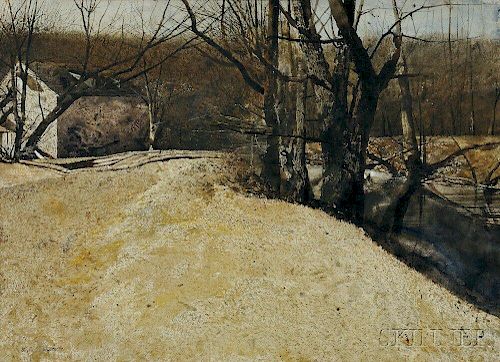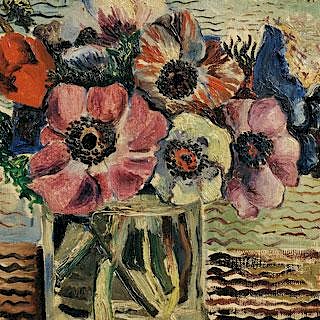Andrew Newell Wyeth (American, 1917-2009) Corn and Grist
Lot 286
About Seller
Bonhams Skinner
274 Cedar Hill Street
Marlborough, MA 01752
United States
Founded over four decades ago, Bonhams Skinner offers more than 60 auctions annually. Bonhams Skinner auctions reach an international audience and showcase the unique, rare, and beautiful in dozens of categories, including the fine and decorative arts, jewelry, modern design, musical instruments, sc...Read more
Categories
Estimate:
$150,000 - $250,000
Absentee vs Live bid
Two ways to bid:
- Leave a max absentee bid and the platform will bid on your behalf up to your maximum bid during the live auction.
- Bid live during the auction and your bids will be submitted real-time to the auctioneer.
Bid Increments
| Price | Bid Increment |
|---|---|
| $0 | $10 |
| $100 | $25 |
| $500 | $50 |
| $1,000 | $100 |
| $3,000 | $250 |
| $5,000 | $500 |
| $10,000 | $1,000 |
| $30,000 | $2,500 |
| $50,000 | $5,000 |
| $100,000 | $10,000 |
| $300,000 | $25,000 |
| $500,000 | $50,000 |
| $1,000,000 | $100,000 |
About Auction
By Bonhams Skinner
Sep 23, 2016 - Sep 24, 2016
Set Reminder
2016-09-23 16:00:00
2016-09-24 16:00:00
America/New_York
Bidsquare
Bidsquare : Fine Paintings & Sculpture
https://www.bidsquare.com/auctions/skinner/fine-paintings-sculpture-1730
Bonhams Skinner bidsquare@bonhamsskinner.com
Bonhams Skinner bidsquare@bonhamsskinner.com
- Lot Description
Andrew Newell Wyeth (American, 1917-2009)
Corn and Grist
Signed "Andrew Wyeth" in ink l.l., identified and dated "1976" on a label from Nicholas Wyeth, Inc., New York, affixed to the frame backing.
Watercolor on paper, sight size 21 1/2 x 29 1/2 in. (54.6 x 75.0 cm), framed.
Condition: Not examined out of frame.
Provenance: From the collection of Howard P. Diamond, M.D., New York, a prominent nasal plastic surgeon, purchased from Nicholas Wyeth, Inc., in 1976.
N.B. Andrew Wyeth was an iconic figure in American painting of the 20th century. Son and student of famed illustrator N.C. Wyeth, the young man seemed destined to follow his father's footsteps yet developed his own individual style. His father's illustrations took as subjects active figures and colorful places from around the word, while Andrew Wyeth found artistic inspiration in friends and family and his immediate surroundings of Chadds Ford, Pennsylvania, and Port Clyde, Maine. His palette, too, was limited, choosing earth-bound shades of brown, green, white, gray, and black rather than the vibrant colors of his father.
Andrew Wyeth painted mainly in watercolor and tempera, and he was a master of the technique described as drybrush. In an interview with friend and Metropolitan Museum of Art director Thomas Hoving, Wyeth explained, "I work in drybrush when my emotion gets deep enough into the subject. So I paint with a smaller brush, dip it into color, splay out the brush and bristles, squeeze out a good deal of the moisture and color with my fingers so that there is only a very small amount of paint left. Then when I stroke the paper with the dried brush, it will make various distinct strokes at once, and I start to develop the forms of whatever object it is until they start to have real body...Drybrush is layer upon layer. It is what I would call a definite weaving process. You weave the layers of drybrush over and within the broad washes of watercolor." (1)
However, for Wyeth technique was never an end in itself, nor was realism. He wrote, "You can have all the technique in the world and can paint the object, but that doesn't mean you get down to the juice of it all. It's what's inside you, the way you translate the object - and that's pure emotion." (2) Wyeth composed his works with an underlying abstraction, examining them upside down to make sure he was getting what he wanted.
Wyeth's famous images such as Christina's World have come to represent America as much as Grant Wood and Andy Warhol, but throughout his career Wyeth's works were both loved and scorned, precisely because he chose not to be part of international modern art movements. One art historian, in response to a 1977 survey in Art News magazine about the most underrated and overrated artists of the century, nominated Wyeth for both categories. (3)
1. Thomas Hoving, Two Worlds of Andrew Wyeth: Kuerners and Olsons, The Metropolitan Museum of Art, 1976.
2. John Toft, Andrew Wyeth on Watercolor, Newsletter 161, Watercolour New Zealand, Inc. http://www.watercolournewzealand.nz/tutorials/article_andrew_wyeth_by_john_toft.htm (accessed 8/17/16)
3. Michael Kimmelman, Andrew Wyeth, Painter, Dies at 91, obituary in the New York Times, January 16, 2009.
Estimate $150,000-250,000
Although the frame was not opened during cataloging, the condition appears good and the framing seems to be original.
The absence of a condition statement does not imply that the lot is in perfect condition or completely free from wear and tear, imperfections or the effects of aging. Condition requests can be obtained via email (lot inquiry button) or by telephone to the appropriate gallery location (Boston/617.350.5400 or Marlborough/508.970.3000). Any condition statement given, as a courtesy to a client, is only an opinion and should not be treated as a statement of fact. Skinner Inc. shall have no responsibility for any error or omission. - Shipping Info
-
Please visit http://www.skinnerinc.com/services/payment-and-shipping/ for information regarding the collection of items purchased at auction.
-
- Buyer's Premium



 EUR
EUR CAD
CAD AUD
AUD GBP
GBP MXN
MXN HKD
HKD CNY
CNY MYR
MYR SEK
SEK SGD
SGD CHF
CHF THB
THB












